calsfoundation@cals.org
Fort Logan H. Roots Military Post Historic District
aka: Fort Roots
In 1893, the U.S. Army chose Big Rock Mountain in North Little Rock (Pulaski County) as the location for one of its new military posts. Fort Logan H. Roots, as it was later named, served as an important military training facility in the late nineteenth and early twentieth centuries. When the United States entered World War I in 1917, Camp Pike (now Camp Joseph T. Robinson) was constructed to provide the military with a larger training facility. In 1921, Fort Roots was transferred to the Public Health Service and became a veterans’ hospital. Today, Fort Roots remains an important part of the Veterans Health Administration.
The history of Fort Logan H. Roots begins with the history of Big Rock Mountain, so named because of its location about three miles upriver from “Le Petit Rocher” (“the Little Rock”). The area remained relatively undeveloped until 1887, when prominent Little Rock (Pulaski County) doctor E. V. Deuell joined Colonel Thomas Lafferty to form the Mountain Park Cottage Site Improvement Company.
Deuell sought to capitalize on the beautiful views of the Arkansas River and the capital city as well as the mountain’s cooler temperatures. The 450-acre site was known as Mountain Park, complete with a hotel, cottages, and scenic overlooks and trails. Local residents enjoyed spending the day at Mountain Park, where the temperature was about five degrees cooler than in Little Rock, and the view was “the grandest …in the state,” according to a letter in the June 7, 1887, Arkansas Gazette.
However, Mountain Park lasted only a few years before Big Rock Mountain was chosen in 1893 as the site for the U.S. Army’s new military post. In an attempt to concentrate military troops in about a dozen large bases near reliable transportation routes (i.e., railroads), Commanding General of the Army John M. Schofield announced in 1890 the closure of several small military posts across the country, including the U.S. Arsenal at 9th and Commerce streets in Little Rock. Thanks to the ingenuity and persuasiveness of Senator James K. Jones; Representative William L. Terry; former Arkansas governor Henry Rector; and Colonel Logan H. Roots, chairman of the Little Rock City Council’s Board of Improvement for the City Park District, a land swap was arranged in which the arsenal grounds were deeded to the City of Little Rock for use as a public park in exchange for 1,100 acres around Big Rock Mountain for the construction of one of the army’s coveted new posts.
Congress initially appropriated $194,760 for the post’s construction, and work began on December 3, 1894. Many of the post’s original buildings were constructed around an 11.7-acre quasi-elliptical parade ground with a view of the Arkansas River and downtown Little Rock. Completed in 1896, Building 1 was the original 135-man enlisted barracks and the most prominent structure facing the parade ground. Other buildings constructed in 1896 included a stockade; a bakery; a quartermaster and commissary storehouse; quartermaster stables; a blacksmith, carpenter, and paint shop; and a powder magazine (Buildings 5, 6, 7, 8, 16, and 18).
Building 11 was constructed in 1896 as a twelve-bed hospital. The two-story red-brick building had porches wrapping around all four sides in order to allow patients access to fresh air and sunshine. Three identical duplex officers’ quarters (Buildings 12, 13, and 14) were constructed in 1896 along a semi-private drive west of the parade ground.
Civil War veteran and prominent Little Rock businessman Colonel Logan H. Roots, who was instrumental in securing both the City Park and the new military post on Big Rock, died at his home on May 30, 1893, before the first phase of post construction was completed in 1896. An order issued in April 1897 by President William McKinley declared that Little Rock’s military post would be named Fort Logan H. Roots in his honor.
The onset of the Spanish-American War in 1898 halted construction at Fort Roots until 1905, with the exception of another duplex officers’ quarters and a fire station (Buildings 24 and 22). The fort’s second major building phase took place between 1905 and 1907 and included an administration building, post exchange and gymnasium, two sixty-five-man barracks each with a mess hall/kitchen and lavatory, commanding officers’ quarters, and nine-man bachelor officers’ quarters (Buildings 32–41 and 54).
Between 1912 and 1916, troops at Fort Roots were trained and mobilized in response to political upheaval in Mexico. However, after the United States entered World War I in 1917, military officials soon realized that Fort Roots was not sufficient to train the necessary troops. The Department of War sought to establish larger training facilities and, on June 17, 1917, again selected North Little Rock as the site for a post. The new facility, called Camp Pike, was easier to access and accommodated a larger number of men. Camp Pike was ready to accept soldiers by September 1917, effectively replacing Fort Roots as the major military training facility.
Fort Roots always maintained a hospital; during the 1918 influenza epidemic, a barracks was converted to a hospital ward to accommodate the increased patient load. Therefore, it made sense for the fort to be transferred in 1921 to the Public Health Service for use as a veterans’ hospital. On April 29, 1922, Executive Order No. 3669 placed Fort Roots under the control of the newly established Veterans Bureau. Today, Fort Roots remains an important part of the Veterans Health Administration, serving veterans in Arkansas and surrounding states. Although Fort Roots has been reduced in acreage over the years, and buildings have come and gone, many of the post’s early structures still circle the parade ground, serving as reminders of the fort’s past. The Fort Logan H. Roots Military Post Historic District was listed on the National Register of Historic Places on September 4, 1974.
For additional information:
Adams, Walter M. North Little Rock, the Unique City: A History. Little Rock: August House, 1986.
Bradburn, Cary. On the Opposite Shore: The Making of North Little Rock. Marceline, MO: Walsworth Publishing Company, 2004.
“Fort Logan H. Roots Military Post Historic District.” National Register of Historic Places nomination form. On file at Arkansas Historic Preservation Program, Little Rock, Arkansas.
Hanley, Ray. Camp Robinson and the Military on the North Shore. Charleston, SC: Arcadia Publishing, 2014.
Little Rock VA Medical Center. “75 Years of Caring, 1922–1997: A History of the VA Medical Center Little Rock/North Little Rock Campuses.” On file at the North Little Rock History Commission, North Little Rock, Arkansas.
“Military Post: The War Department’s Selection of Big Rock Discussed by Commissioner Roots.” Arkansas Gazette. February 16, 1893, p. 1.
Miller, Janet. Chronicle of a Century: The Story of Fort Roots. North Little Rock, AR: Veterans Administration Medical Center, 1993.
Roy, F. Hampton, Sr., and Charles Witsell Jr., with Cheryl Griffith Nichols. How We Lived: Little Rock as an American City. Little Rock: August House, 1984.
Silva, Rachel. “Pulaski County in the National Register of Historic Places: Fort Logan H. Roots Military Post Historic District.” Pulaski County Historical Review 58 (Spring 2010): 28–35.
Thilo, Lisa D. “Fort Logan H. Roots, North Little Rock, Arkansas.” Pulaski County Historical Review 46 (Spring 1998): 2–17.
Rachel Silva
Arkansas Historic Preservation Program
 Health and Medicine
Health and Medicine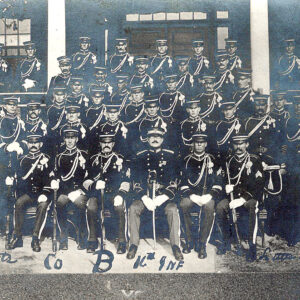 Fort Logan H. Roots Company B
Fort Logan H. Roots Company B 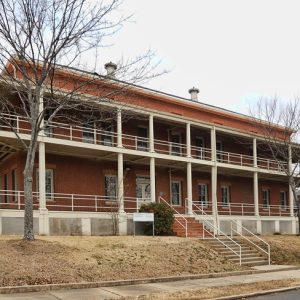 Fort Roots Building 11; 2010
Fort Roots Building 11; 2010 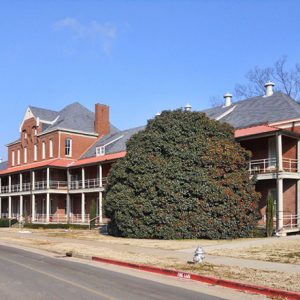 Fort Roots Building 1; 2010
Fort Roots Building 1; 2010 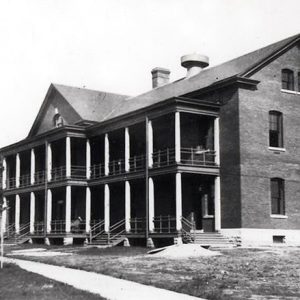 Fort Roots Building 37; 1908
Fort Roots Building 37; 1908  Fort Roots Building 37; 2010
Fort Roots Building 37; 2010 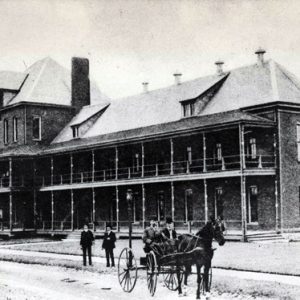 Fort Roots Building 1; 1900
Fort Roots Building 1; 1900 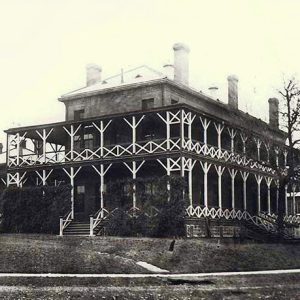 Fort Roots Building 11; 1905
Fort Roots Building 11; 1905 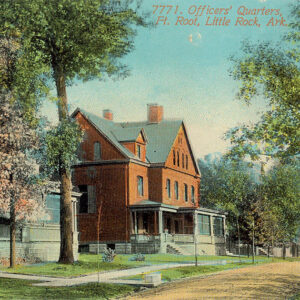 Fort Logan H. Roots Officers' Quarters
Fort Logan H. Roots Officers' Quarters 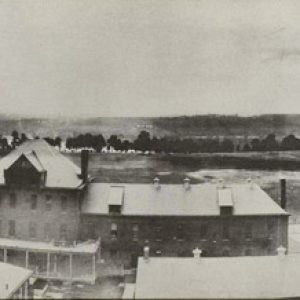 Fort Logan H. Roots Panorama
Fort Logan H. Roots Panorama 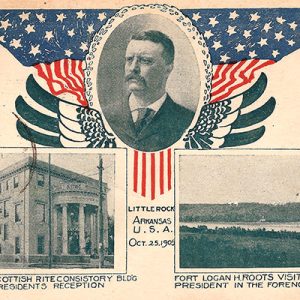 Roosevelt Visit
Roosevelt Visit 




Comments
No comments on this entry yet.